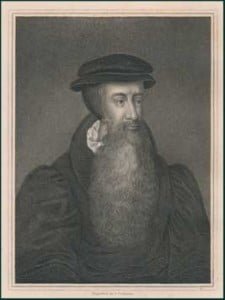by davidtmyers |
Anyone who has been called into the ministry of the Word of God prays for a godly response in the hearts of the listeners. Certainly this was the desire of the Reformers in Scotland in the sixteenth century. To put away all things that dishonor His name was the prayer of those who entered into the sacred calling. But it didn’t always work out that way in practice.
 John Knox had returned to Scotland from Geneva Switzerland on May 2, 1559 (See that post on TDPH for a review). Beginning to preach the Reformed Faith to his fellow Scotsmen, John Knox had preached a thunderous sermon to the citizens of Perth, Scotland. The subject of his sermon exposed the idolatry of the Roman Church which included the worship of images.
John Knox had returned to Scotland from Geneva Switzerland on May 2, 1559 (See that post on TDPH for a review). Beginning to preach the Reformed Faith to his fellow Scotsmen, John Knox had preached a thunderous sermon to the citizens of Perth, Scotland. The subject of his sermon exposed the idolatry of the Roman Church which included the worship of images.
Immediately following that message, a Roman Catholic priest unwisely attempted to serve mass. A young boy showed his displeasure at the attempt, for which he was struck by the priest. The boy retaliated by throwing a stone, which broke one of the images on the altar. Soon, the spectators of the altercation proceeded to favor the young boy’s action, by breaking all the images in the church. It turned into a riot when a mob proceeded to enter into all the Roman Catholic churches and even the monasteries, and lay them to ruins. Even John Knox, who tried to stop the unruly mob, referred to them as “a rascal multitude.”
Queen Mary of Guise, the queen regent, responded by calling forth her army, augmented by French troops in the area, and advanced to the city of Perth, threatening to lay waste the town and the citizens of it. The Protestant Lords of the congregation were able to assembly 25,000 soldiers to protect the Protestants. Obviously, a military showdown was about to take place. The queen regent, Mary, anxious to avoid such a showdown, entered then into an agreement that the town would be left open to the Queen, that none of its inhabitants would be interfered with, that the French troops would not enter the city, and that when the Queen would leave, there would be no garrison of troops left in the town.
All of these actions led to that which has been called the Second Covenant, signed and sealed on May 31, 1559. By this, those who signed the covenant resolved 1) to maintain their evangelical confederation; 2) to do all things required by God in the Scriptures; 3) to observe true worship; 4) to preserve the liberty of the Congregation and each member of it. These four points made up this Second Covenant, which was signed in the name of the whole Congregation, with the specific names of the Earls of Argyle and Glencairn, Lord James Stewart, Lord’s Boyd and Ochiltree, and Matthew Campbell.
The Second Covenant was immediately put to the test as the Queen Regent, Mary of Guise, turned her back on all of her promises to the Protestants. The battle for the soul of the nation was set to continue in the land.
Words to Live By:
It would be easy to resort to fleshly means to bring about the spiritual kingdom of God in a land. Our spiritual ancestors in Scotland were under a different standard as they sought to put away all things that dishonor His name. That is what this Second Covenant was all about on this day in 1559. Through godly prayer and spiritual works, as our Confessional Fathers put it, we are to destroy the kingdom of Satan, advance the kingdom of grace, and hasten the kingdom of glory.
It would be easy to resort to fleshly means to bring about the spiritual kingdom of God in a land. Our spiritual ancestors in Scotland were under a different standard as they sought to put away all things that dishonor His name. That is what this Second Covenant was all about on this day in 1559. Through godly prayer and spiritual works, as our Confessional Fathers put it, we are to destroy the kingdom of Satan, advance the kingdom of grace, and hasten the kingdom of glory.
